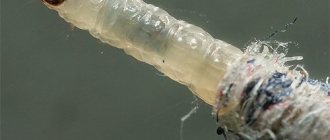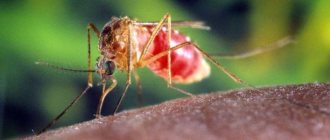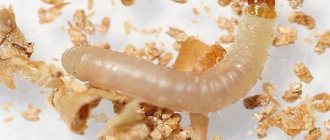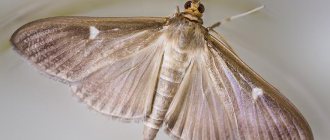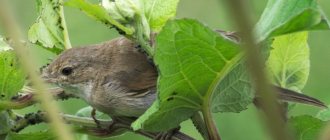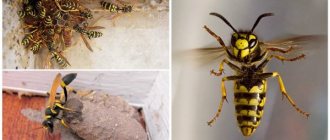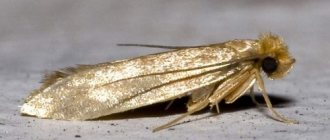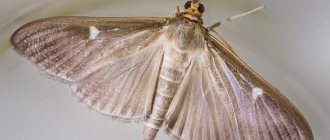Various pests can appear in the house if favorable conditions are created for them. One of the insects that become frequent guests in the kitchen is the food moth. It multiplies quickly and can spoil many products that become unfit for consumption. If traces of the presence of food moths are detected, it is necessary to take action as soon as possible. The approach to pest control must be comprehensive. First you need to find and eliminate the source of infection, carry out a thorough cleaning, and then treat the food and all surfaces.
Description of the pest
The food moth is a silver-white insect. There are special designs on the wings. The parasite can appear in the kitchen of clean housewives. Grain becomes infected with the pest in warehouses and storage facilities. It goes to stores, and from there into customers' bags. Therefore, moths appear quickly, and getting rid of them is problematic. It is important to catch the moment while there are few insects, otherwise they will spoil absolutely all the supplies.
The grain moth is widespread throughout Europe, as well as in Australia, Benin and Brazil.
If the conditions are comfortable, the moth becomes a real mistress in the kitchen. While on the cereals, females lay eggs in large quantities. The larvae, which appear in food after a short time, begin to eat food with an enviable appetite. The main emphasis is on flour, buckwheat, rye, rice, wheat.
After the caterpillar grows up, it secretes a special web with which it glues the grains together and then carries them around. Eventually, the caterpillar finds a secluded corner behind the baseboard or in a crack, creates a cocoon - a pupa is formed. Over time, a new butterfly will appear.
What is food moth
The insect is a pest with a short breeding cycle. Food or grain moths belong to the butterfly family. Adults are beige in color, sometimes light brown. There are also larvae that look like caterpillars; the eggs are light-colored. The larvae vary in size depending on the type of insect, sometimes reaching a length of two centimeters. It is this form of the pest that is considered the most harmful to humans. The larvae devour food and envelop nuts, fruits and cereals in an unpleasant web.
The maximum lifespan of an adult (butterfly) does not exceed several days, then the insect lays eggs and dies. During the breeding season, the pest turns into a wingless butterfly, when it destroys many food supplies. This period can last up to six days. The reproduction process of grain moths is accelerated if the environment is warm and humid. Therefore, the absence of flying moths is not a reason for peace. At this moment, the larvae can safely feast on your supplies.
Note! The most important thing in the fight against insects in the kitchen is to periodically check all containers with dry products, and not just get rid of the pest once.
Fighting methods
All cereals and dried fruits must be placed in tightly sealed containers to prevent moths from reaching them.
Grain moth loves unventilated, warm, damp rooms . You can get rid of it in various ways:
- For preventive purposes, store grains in closed jars and tied plastic bags.
- It is recommended to throw away already affected products. If some of the grains are little affected, they can be processed in the oven for 15 minutes, temperature – 60 degrees. You can use a regular microwave.
- The cabinets where the grain is located are processed. The cracks are coated with a vinegar solution, and the shelves are washed with soapy water. The cabinet door should be open until it dries completely.
Life cycle of an insect
The grain moth in the form of a butterfly appears in the spring - March-April. The female lives from 5 to 13 days. During this time he does not eat anything, only drinks water. The main task is to choose a convenient place and lay eggs. During its life it is capable of laying 150–283 pieces. They are placed individually or in a group. Each time 15 eggs. The caterpillars appear within 4–28 days. Such a significant difference depends on the environment in which they find themselves. Under favorable conditions the process occurs much faster.
Particular harm is caused by caterpillars, which make their home in grains and feed on them. The larva gnaws through the grain and climbs inside. By the time the caterpillar matures, it turns into a hollow container with a rim. Only one piece is needed. The grains of barley, wheat, rye, and rice contain one individual. There may be two of them in corn. Life expectancy 3 weeks. After this, the pupation process begins.
The caterpillar gnaws a fairly large hole so that the butterfly can safely get out of the shelter. The development of the insect depends on the time of year. In summer it takes 7–10 days, in autumn – about 15 days, in winter – much more.
Under favorable conditions, the generation of this pest develops in 25–35 days. If unfavorable – 34–90. The moth is sensitive to ambient temperature. Overwinters in the pupal state. The life-threatening threshold is 13 degrees below zero.
Special preparations
The safest way to get rid of a food moth infestation is to use pheromone-based traps
You can get rid of moths by various means - tablets, plates, sprays, etc.
The good thing about the plates is that they don’t have an unpleasant odor. They destroy not only adults, but also larvae. Combat readiness is maintained for six months.
The first signs of the appearance of moths
As a rule, it is the adults who are noticed first. At night, like any other butterflies, they are attracted to any source of light. And it’s hard not to pay attention to the moths circling around the kitchen lamp.
Traces of her vital activity in bags of groceries are even clearer. If some peas or pearl barley have stood for a long time in the farthest corner of the cabinet, moths can turn them into complete dust.
Even if the feeding process does not last so long that it comes to rot, the product will still be contaminated with traces of vigorous vital activity: from cocoons with scales to dead insects and their excrement. This is why you should never try to save the remains of damaged cereal by sorting through it. It's best to throw away the entire package. There is nothing useful for nutrition left in it after the moth appears.
The larvae of food moths are practically omnivorous: they generally thrive on dried fruits
Natural remedies
Essential oils - fir, lavender - will help get rid of parasites. You can use bouquets of dried lavender. Moths cannot tolerate the smell of strawberry soap, tobacco, dry orange peels, and pepper. You can use fresh geranium leaves.
Of all the folk remedies against moths, lavender is perhaps the most famous.
It is important to know that the products presented are repellents . They will only repel insects for a while. If moths have already infested the closet, you will have to use chemicals.
Prevention and advice
How to deal with food moths? Don't forget about prevention, because it will cost you much less than throwing away food!
- Store groceries correctly in the kitchen. Immediately after purchasing, pour cereals and flour into glass jars, plastic containers with tight lids, throw a clove of garlic and a bay leaf into each container. You can fry bulk products or keep them in the freezer before storing. Plastic or linen bags do not protect cereals from the ubiquitous moth: its larvae easily gnaw through such material.
- Periodically inspect your closets and ventilate them more often.
- Do not buy cereals in damaged packaging, do not stock up on groceries for future use.
- Unfortunately, you won’t be able to get rid of the uninvited guest forever, but you can still scare her away. Moths cannot tolerate strong odors, so place dried herbs in the kitchen: mint, lavender, wormwood, pine needles. Tea tree oil and eucalyptus oil also help: soak cotton pads in it and put them in cereal containers. Spices are also suitable for fighting insatiable moths: bay leaf, cloves. Place geraniums in the kitchen, the scent of which moths cannot tolerate, and lay out pieces of laundry soap. Or buy a repeller or fumigator. Such preventive measures only affect adult individuals, but have no effect on eggs or larvae.
- In your apartment, take the trouble to cover all the hoods and ventilation holes. Fight, don’t be lazy, and voracious moths will no longer settle in your kitchen, either in a package of dried fruit or in a jar of semolina!
Traditional methods
Let's look at the most common folk remedies.
- Wrigley's Spearmint Chewing Gum. Simply unwrap the wrapper and place the gum in the cabinet.
- Bay leaf. It is placed next to food.
- Trap with boric acid. Boric acid and flour are mixed - proportions 1 to 3. Then the product is placed in a tin can, which is placed in a closet. The presented method only works on larvae.
Place bay leaves around the perimeter of shelves with cereals, as well as in jars where foods are stored that attract butterflies and moths will go away
After processing or cleaning, it is necessary to thoroughly ventilate the room . Observe the kitchen for three days. During this time, the larvae may reappear and will need to be removed urgently. It is important to pay attention to the cracks. This is where moths most often lay eggs.
To prevent moths from entering the house, you should seal all the places from which they crawl with a special mesh with small holes. Don't forget to seal the vents! You can also find out what to do if there are moths in dried fruits.
How do ermine moths reproduce?
2 weeks after birth from the pupae, the insect begins to mate. Egg laying is observed 5-6 days after fertilization. For protection, the female covers the eggs with mucus, which forms a shield. The fertility of a female individual ranges from 20 to 100 eggs.
The eggs are tiny in size; on top they are covered with a honey-colored shield 4-5 mm thick. Over time, it turns red, and then brown, and finally it merges with the bark of the tree.
The duration of embryonic development is 1-2 weeks. The initial diet consists of egg shells and tree bark. The larvae do not leave the scutellum until winter.
The male genital organs consist of two testes that pass into the vas deferens. Females have short anal papillae and relatively convex vaginal plate lobes. As a result of bisexual reproduction, a single generation appears every year.
Preventive measures
Most often, moths enter the house with purchased bulk products - flour and cereals
- Freeze purchased products for at least a week. If they contain moth eggs, they will freeze. This measure will save you from problems in the future.
- Cereals should be stored in hermetically sealed jars. When using bags, insert one into the other.
- If you decide to fight moths in the summer, you can spread the purchased cereals in a thin layer on a cloth and take it out into the sun.
- Moths also do not tolerate frost well. Therefore, food can be frozen twice. The temperature should reach at least -10 degrees. The procedure lasts up to 10 hours. Next, the grains are heated to +10. Some housewives prefer to store peas and beans in the refrigerator.
Check inventory periodically. This way you will prevent the appearance and spread of the parasite.
If food moths appear in your home, you should get rid of them as quickly as possible. For this, various methods can be used, both store-bought and folk. As a rule, folk remedies provide only a temporary effect. If the parasites have already spread throughout the kitchen, it is better to use chemicals. If you take preventive measures: timely cleaning and sorting of grains, problems will not arise.
What does an ermine moth look like (photo)
Judging by the title, readers probably immediately associate it with a parasite on the furry animal ermine. However, this is not at all true. To know this, you need to know your enemy by sight.
This is what a harmless moth looks like.
And these are her larvae.
This happens if you don’t start fighting the pest in time.
During the period of mass reproduction, caterpillars form large cobweb nests on trees; at an accelerated pace, they literally leave trees without foliage in a week, enveloping them in a cobweb shroud.
Scientists associate the rapid reproduction of ermine moths with increased solar activity, which is observed every 11-12 years. However, during increased solar activity, plant biomass increases, that is, the food supply for pests increases. So they reproduce in greater numbers.
However, thanks to its greater resilience, bird cherry is the first to take the blow. Completely destroyed foliage on trees after pupation of the caterpillars grows foliage again after a month. But even if you cut down the affected tree, you will not get rid of the pest, because all the larvae have gone into the ground. And next year they will attack your trees again with new, and perhaps even greater, force.
How to deal with a pest
Pest control takes a lot of time, money and effort. As you know, it is easier to prevent than to remove. Therefore, it is initially necessary to properly prepare the room where supplies will be stored.
- Clean up and remove all dirt;
- Check for pests;
- Carry out preventive disinfection using a spray or solution.
- Then pay attention to the cultures themselves;
- Dry the grain well or until half cooked;
- Remove damaged, remove dirt;
- Ensure storage temperature is as low as possible;
- Large quantities of stock can be sprayed with insecticides.
What damage can moths cause to grain stocks?
Most often, caterpillars damage grain mounds of wheat, corn, barley and rye. They penetrate into the top layer of the embankment, on average 5-8 cm deep (in some cases up to 22 cm). It is also not uncommon for an insect to enter a storage facility while already inside the grains. The hidden type of infection makes it difficult to detect the pest in time.
In the absence of measures, moths can destroy 40% of stocks in 6 months. Infected grain loses more than 50% of its weight and becomes unsuitable for use in the food and feed industries.
